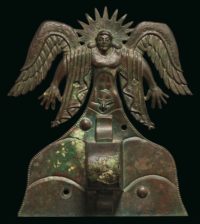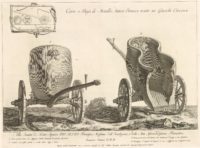 The J. Paul Getty Museum is the proud new owner of an exceptional Etruscan bronze appliqué depicting the sun god Usil. Dating to the early 5th century B.C. (500-475 B.C.), the striking piece is eight inches high and features Usil standing with arms at his sides, fingers splayed, a nimbus of solar rays adorns his head and large wings spread from his shoulders. He wears a mantle draped over both shoulders and a diadem.
The J. Paul Getty Museum is the proud new owner of an exceptional Etruscan bronze appliqué depicting the sun god Usil. Dating to the early 5th century B.C. (500-475 B.C.), the striking piece is eight inches high and features Usil standing with arms at his sides, fingers splayed, a nimbus of solar rays adorns his head and large wings spread from his shoulders. He wears a mantle draped over both shoulders and a diadem.
As with the Greek and Roman sun deities, Usil drove the sun from the eastern sea west across the sky on his chariot, and it’s likely this piece was used to decorate just such a vehicle, albeit a more terrestrial iteration. The back of the bronze is unworked and flat and there are four places for attachment pins (two pins have survived) in the center and base which were used to mount it to something made of wood. Etruscan nobles were often buried with their chariots, and ornaments like the bronze appliqué of Usil would be attached to them to link them to the mythological motif of the sun being driven through the sky.
 A very similar fitting was discovered in excavations between 1760 and 1775 at the Roma Vecchia estate on the Appia Antica by gemstone carver Antonio Pazzaglia. This was the first conscious discovery of an archaic chariot, although people at the time thought it was Roman, not Etruscan, and Pazzaglia put the extant pieces back together in something of a fanciful manner with interpolations from other locations and time periods, a commonplace practice at the time. Engraver Francesco Piranesi, eldest son on the famous documenter of antiquities Giovanni Battista Piranesi, indulged in a fancy of his own when he depicted it as a triumphal chariot from the Augustan era in a 1778 he co-authored with his father. It looks nothing like that today — now in the Vatican Museums, it was restored to our best knowledge of historical accuracy in the 1990s — but the print clearly shows the Usil plaque, the first of its kind ever discovered.
A very similar fitting was discovered in excavations between 1760 and 1775 at the Roma Vecchia estate on the Appia Antica by gemstone carver Antonio Pazzaglia. This was the first conscious discovery of an archaic chariot, although people at the time thought it was Roman, not Etruscan, and Pazzaglia put the extant pieces back together in something of a fanciful manner with interpolations from other locations and time periods, a commonplace practice at the time. Engraver Francesco Piranesi, eldest son on the famous documenter of antiquities Giovanni Battista Piranesi, indulged in a fancy of his own when he depicted it as a triumphal chariot from the Augustan era in a 1778 he co-authored with his father. It looks nothing like that today — now in the Vatican Museums, it was restored to our best knowledge of historical accuracy in the 1990s — but the print clearly shows the Usil plaque, the first of its kind ever discovered.
This plaque was one of four similar ones unearthed in 1845 in the Tomb with the Quadriga in Vulci, a spectacular chariot burial that included the skeletal remains of horses along with the chariot they would have pulled in life. Each of the appliqués are slightly different, with variations in plate form, size, rivet position and facial features, but the evidence suggests they were all made by the same bronze-casting shop in Vulci, a prominent Etruscan city that was known for its outstanding metal work.
Two of the plaques from the Quadriga Tomb are in the National Etruscan Museum of the Villa Giulia in Rome and one in the Hermitage Museum in Saint Petersburg. This was the only one of the group in private hands, and is the best preserved of all of them. It sold at a Christie’s auction in December 2017 for £296,750 ($410,400). Now we know the buyer was the Getty Museum.
“This bronze appliqué that probably decorated an Etruscan chariot or funeral cart is of exceptional quality, representing the peak period of an artistic milieu in which Greek and Italic aesthetics merged to create a distinctively Etruscan style,” says Timothy Potts, director of the J. Paul Getty Museum. “Bronze statuettes and reliefs are a particular strength of the Getty’s collection of Etruscan art and the Usil appliqué’s rarity and quality will assure it a significant presence in the newly reinstalled gallery at the Villa dedicated to this fascinating culture.” […]
This newest acquisition will go on display in the reinstalled Getty Villa when it opens in April 2018, and will join several related Etruscan bronzes, including a vessel foot depicting Usil in winged boots running over the crests of waves; and a lion head attachment with glass paste eyes, which likely capped the end of a chariot pole. A pair of candelabra with finials of a youth dancing and playing castanets is also attributed to a Vulcian workshop, which produced fine metalware for an international Mediterranean clientele.
The appliqué was acquired in the 1920s in Monte Carlo by Sylvie Bonneau-Arfa (b. about 1907), née Fatma-Enayet Arfa, the daughter of the Persian ambassador to the Russian court. In 1970 the appliqué went up for auction but failed to sell and was returned to the family. It had been brought to the attention of the Swiss archaeologist Hans Jucker in 1968, and was subsequently on loan to the Historisches Museum in Bern, Switzerland during the 1970s. The Getty acquired it at auction from the descendants of Ms. Bonneau-Arfa.
Obviously the Etruscan counterpart of the Mercedes-Benz star as hood ornament – Pure horsepower before Usil’s sun! 😎
“Tell us about the sky of your homeworld, Usil”
I wonder if the curving lines at the base were intended to evoke clouds that Usil is rising above.
The Vatican Museums link is not working for me – maybe it requires one to be logged in?
Cordate, it’s not working for me, either 🙁
Someone should indeed make the Vatican’s holy ‘Content Management System‘ catholic again. At least, it seems to be run obove the ‘SUN‘ operating system.
The text is delivered and (working!) links to pictures of the vehicle too, but unfortunately not in an orthodox way. The ‘(ev?)angelion’ that they are trying to bring across, however, is this:
——————————-
“Room I. Proto-history in Etruria and Latium – Archaic chariot
The chariot, discovered around the end of the eighteenth century, joined the Vatican collections in 1804, having been sold by Antonio Pazzaglia, a renowned carver of precious stones, who had carried out its restoration according to the logic of the antique market of the period, assembling original and heterogeneous parts by chronology and origin. The most recent restoration work, carried out in 1992, enabled the chariot to be reconstructed, starting from the few elements that are known to be original.
The wooden structure was reconstructed through the surviving fragments of the bronze casing and the study of similar vehicles found in excavations or represented on ancient objects from the same age. A prized example of bronze work is offered by the eagle-head tip at the end of the shaft, worked cold using a chisel and punch. The possible location of its discovery is between the fifth and sixth mile of the Appian Way, in the area of the Villa dei Quintili, near the Cluilian Trench, the ditch that traditionally marked the boundary between the territory of Alba Longa and Rome, and the backdrop to the mythical battle between Horatius and Curiatius at time of Tullus Hostilius.
Detail of the eagle-head tip (Chariot 20829)
A fine example of ancient bronze work is given by the shaft tip in the form of an eagle’s head, reproduced in detail here. Technological and stylistic details would indicate that this protome, hypothetically attributed to a workshop in Chiusi, belongs to the ancient bronze-working tradition of inner Etruria, where there was a particular concentration of this type of prestigious item. It testifies to the marked influence of Greek-Oriental sculptural works, notably bronzes and shaped vessels, which certainly constituted a model for reference.
From the Roma Vecchia estate, 550-540 B.C.
Laminated and cast bronze, on modern wooden reconstruction, Cat. 20289
No resource found
Cannot serve request to /content/museivaticani/en/collezioni/musei/..html on this server
ApacheSling/2.2 (Day-Servlet-Engine/4.1.52, Java HotSpot(TM) 64-Bit Server VM 1.7.0_60, SunOS 5.11 sparcv9)”
——————————-
Interesting – the link worked fine for me – though the image didn’t show till after I’d told NoScript that the site was ok.
I was curious to see the word appliqué used for this as that is usually used in reference to applying something to fabric not wood but considering how accurate you normally are I’ll accept it’s use here 🙂